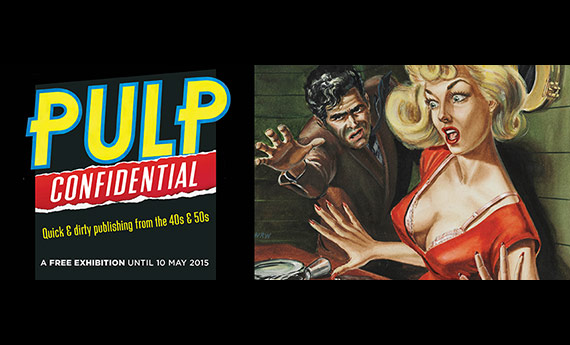
Get the inside scoop!
Curator Peter Doyle became a household name in 2007 when City of Shadows opened at the Justice and Police Museum showing the NSW Police Forensic Archive in all its noir and seedy crime scene photography. Our appetite for our sinister city proved unquenchable and City of Shadows was extended twice and is again currently showing at the Justice and Police Museum. Peter Doyle followed up in 2009 with Crooks Like Us, which explored the mug shots within the archive. Now Peter Doyle is back, this time with Pulp Confidential: Quick & dirty publishing from the 40s & 50s.
This exhibition at the State Library is a jaunty look at the outputs of Sydney based publishing house, Frank Johnson Publications. It’s an exhibition which embraces all the elements of pulp: it’s honest and unpretentious, curated against bright and bold walls in a dim-lint room, unambiguous and to the point.
The show explores the graphic qualities of the genre along with the story of the rise of pulp popularity at a time when trashy crime novels were blamed for cultural and social decay. Then, the term pulp had none of the hip connotations it has now. Moral crusaders united from left and right to ban the pulp materials, especially the violent and sexualised comics and crime stories.
Prior to the 1940s, Australian readership for pulp had been dominated by magazines from the US. However, during a brief banning of printed imports in Australia, the local publishers joyfully filled the void. Small publishing houses turned from publishing ‘sensible’ journals and periodicals to publishing weekly pulp. And the market was ready and hungry for more.
Moral crusaders united from left and right to ban the pulp materials ...
Hundreds of new publications crammed the newsstands and bookstores each week. Pocket-sized books were popular for easy fit and quick consumption on daily commute trains. Since the books were easily disposable, paper quality was very poor. It is amazing that any pulp has survived today.
Among the original lurid magazine cover art in bold and bright colours with urgent brush work and sensational titles to match, are the business workings of Frank Johnson and his printery; contracts documenting wages of the writers and artists, significantly low compared to now; letters written to the editors hassling for small sums of money; decorated envelopes and letters; as well as rejected ideas and its finished artwork.
Although the pulp publishing industry has eventually declined through the influence of television, the graphic novel, and Japanese anime, it is now a major driver of culture, cinema and even fine art. In a market flooded with all manner of crime-related cultural product, it is difficult to relate to the panic and disdain pulp caused at the time. A fact that makes Pulp Confidential more enjoyable, humorous and lively – on at the State Library until 10 May.
Meet Hanna Kim Hong, one of our roving reporters. Mother of a young family and legal advocate with the Arts Law Centre, Hanna still gets time to check out what’s on in galleries and museums about town. Read what she’s got to say.




